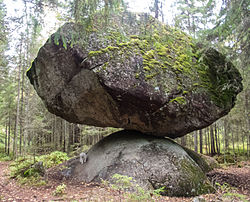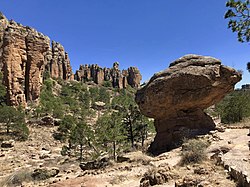
A balancing rock, also called a balanced rock, precariously balanced rock (PBR), or precarious boulder, is a naturally occurring geological formation featuring a large rock or boulder, sometimes of substantial size, resting on other rocks, bedrock, or on glacial till. Some formations known by this name only appear to be balancing, but are in fact firmly connected to a base rock by a pedestal or stem.
Contents
- Categories
- Notable balancing rocks
- Africa
- Asia and Australia
- Europe
- North America
- South America
- See also
- References
- External links
No single scientific definition of the term exists, and it has been applied to a variety of rock features.


















